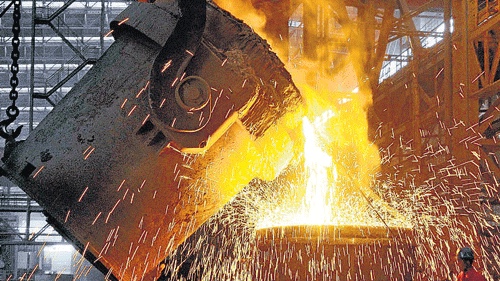
Steel plant.
Credit: PTI File photo
Roughly two years' worth of global carbon emissions could be cut down by 2050 if iron and steel plants worldwide were upgraded earlier than their scheduled repair, scientists report in a new Nature study.
While upgrading these processing plants with low-emissions technology five years earlier than their scheduled refit could lower 70 gigatonnes of carbon emissions, retrofitting them at their scheduled refit could cut down roughly 60 gigatonnes of emissions, the researchers from the University College London, UK, said in their study.
Most of the total projected carbon savings, about 74 per cent, could be achieved by upgrading blast oxygen furnaces globally, all of which contribute to around 63 per cent of the world's steel production, the research team found by creating a vast database of more than 19,500 individual processing units across nearly 4,900 iron and steel plants.
The second highest net carbon savings (16 per cent of the projected total) could come from retrofitting electric arc furnaces, responsible for the remaining global steel production, they found. However, they also found this could be influenced by scrap available as the retrofitting technique depends on recycling existing metals.
Being a carbon-heavy process, about 7 per cent of the global emissions are estimated to come from iron and steel production.
The researchers said that some of the most carbon-intensive, coal-based production plants were concentrated in China, Japan, and India, while Middle Eastern and North American plants, with greater access to natural gas resources, use techniques emitting relatively less carbon dioxide.
They also said that retrofitting the top five carbon emitting iron and steel plants, four in China and one in South Korea, would demonstrate the feasibility for other, similar plants.
These five plants cause 7 per cent of all the iron-and-steel carbon emissions, but only make up 0.1 per cent of the 4,883 plants they studied, they said.
Upgrades to coal powered plants, known to cause considerable emissions, are usually undertaken at the end of a processing unit's operational lifetime owing to financial and time considerations, even as technologies reducing emissions in such plants exist, the researchers said as they found about 74.5 per cent of the world's steel to come from such plants (as of 2019 data).
Further, the frequency of retrofits in iron and steel plants in general typically occur after 15 to 27 years of use, depending on techniques employed and the plant's age.
Overall, 43.2 per cent of these plants have been retrofitted with new technologies or have enhanced their processes to extend their operating lifetime, the researchers found.